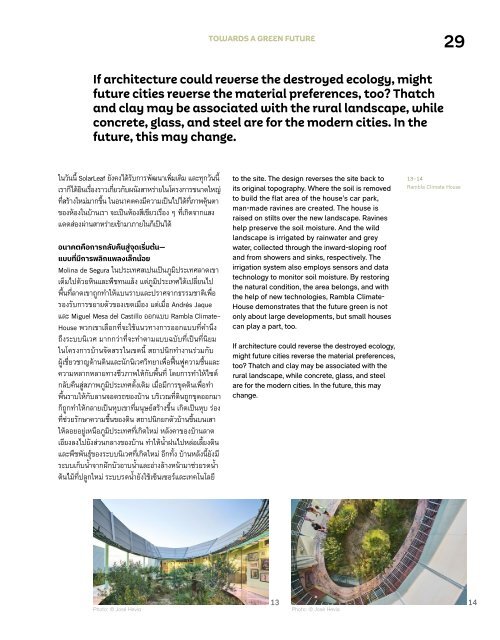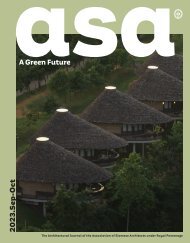ASA Journal 15/2023
Create successful ePaper yourself
Turn your PDF publications into a flip-book with our unique Google optimized e-Paper software.
TOWARDS A GREEN FUTURE<br />
29<br />
If architecture could reverse the destroyed ecology, might<br />
future cities reverse the material preferences, too? Thatch<br />
and clay may be associated with the rural landscape, while<br />
concrete, glass, and steel are for the modern cities. In the<br />
future, this may change.<br />
ในวันนี้ SolarLeaf ยังคงได้รับการพัฒนาเพิ่มเติม และทุกวันนี้<br />
เราก็ได้ยินเรื่องราวเกี่ยวกับผนังสาหร่ายในโครงการขนาดใหญ่<br />
ที่สร้างใหม่มากขึ้น ในอนาคตคงมีความเป็นไปได้ที่ภาพคุ้นตา<br />
ของห้องในบ้านเรา จะเป็นห้องสีเขียวเรือง ๆ ที่เกิดจากแสง<br />
แดดส่องผ่านสาหร่ายเข้ามาภายในก็เป็นได้<br />
อนาคตคือการกลับคืนสู่จุดเริ ่มต้น—<br />
แบบที่มีการพลิกแพลงเล็กน้อย<br />
Molina de Segura ในประเทศสเปนเป็นภูมิประเทศลาดเขา<br />
เต็มไปด้วยหินและพืชทนแล้ง แต่ภูมิประเทศได้เปลี่ยนไป<br />
พื้นที่ลาดเขาถูกทำาให้แบนราบและปราศจากธรรมชาติเพื่อ<br />
รองรับการขยายตัวของเขตเมือง แต่เมื่อ Andrés Jaque<br />
และ Miguel Mesa del Castillo ออกแบบ Rambla Climate-<br />
House พวกเขาเลือกที่จะใช้แนวทางการออกแบบที่คำานึง<br />
ถึงระบบนิเวศ มากกว่าที่จะทำาตามแบบฉบับที่เป็นที่นิยม<br />
ในโครงการบ้านจัดสรรในเขตนี้ สถาปนิกทำางานร่วมกับ<br />
ผู้เชี่ยวชาญด้านดินและนักนิเวศวิทยาเพื่อฟื้นฟูความชื้นและ<br />
ความหลากหลายทางชีวภาพให้กับพื้นที่ โดยการทำาให้ไซต์<br />
กลับคืนสู่สภาพภูมิประเทศดั้งเดิม เมื่อมีการขุดดินเพื่อทำ า<br />
พื้นราบให้กับลานจอดรถของบ้าน บริเวณที่ดินถูกขุดออกมา<br />
ก็ถูกทำาให้กลายเป็นหุบเขาที่มนุษย์สร้างขึ้น เกิดเป็นหุบ ร่อง<br />
ที่ช่วยรักษาความชื้นของดิน สถาปนิกยกตัวบ้านขึ้นบนเสา<br />
ให้ลอยอยู่เหนือภูมิประเทศที่เกิดใหม่ หลังคาของบ้านลาด<br />
เอียงลงไปยังส่วนกลางของบ้าน ทำาให้น้ำาฝนไปหล่อเลี้ยงดิน<br />
และพืชพันธุ์ของระบบนิเวศที่เกิดใหม่ อีกทั้ง บ้านหลังนี้ยังมี<br />
ระบบเก็บน้ำาจากฝักบัวอาบน้ำาและอ่างล้างหน้ามาช่วยรดน้ำา<br />
ต้นไม้ที่ปลูกใหม่ ระบบรดน้ำายังใช้เซ็นเซอร์และเทคโนโลยี<br />
to the site. The design reverses the site back to<br />
its original topography. Where the soil is removed<br />
to build the flat area of the house's car park,<br />
man-made ravines are created. The house is<br />
raised on stilts over the new landscape. Ravines<br />
help preserve the soil moisture. And the wild<br />
landscape is irrigated by rainwater and grey<br />
water, collected through the inward-sloping roof<br />
and from showers and sinks, respectively. The<br />
irrigation system also employs sensors and data<br />
technology to monitor soil moisture. By restoring<br />
the natural condition, the area belongs, and with<br />
the help of new technologies, Rambla Climate-<br />
House demonstrates that the future green is not<br />
only about large developments, but small houses<br />
can play a part, too.<br />
If architecture could reverse the destroyed ecology,<br />
might future cities reverse the material preferences,<br />
too? Thatch and clay may be associated with the<br />
rural landscape, while concrete, glass, and steel<br />
are for the modern cities. In the future, this may<br />
change.<br />
13-14<br />
Rambla Climate House<br />
Photo: © José Hevia<br />
13<br />
Photo: © José Hevia<br />
14

















